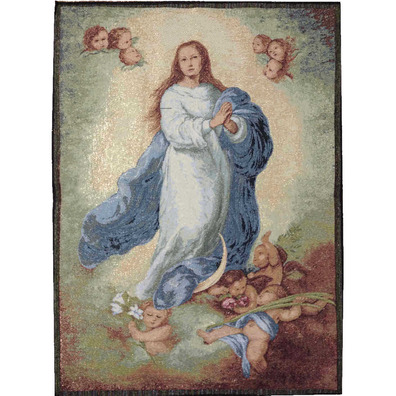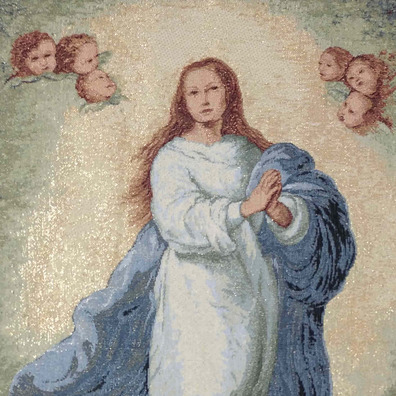Immaculate Conception of El Escorial Wall Hanging Tapestry
25,00€
Taxes includedCatholic product in stock. Products ready to be shipped. You can check the approximate delivery time during the purchase process.
Immaculate Conception of El Escorial Wall Hanging Tapestry | Online Sale
- Decorative tapestry inspired by the artwork "The Immaculate Conception of El Escorial" by Bartolomé Esteban Murillo.
- 50 cm wide by 70 cm high (19.7 inches by 27.6 inches).
- Made with cotton and viscose.
- Available other Virgin Mary Catholic tapestries.
Symbolism and Historical Context of the Tapestry of the Immaculate Conception of El Escorial
The tapestry of the Virgin reproduces the famous artwork by Bartolomé Esteban Murillo, The Immaculate Conception of El Escorial.
Murillo's original painting is an oil on canvas dating from around 1665. This version of the Immaculate Conception received the name " The Immaculate Conception of El Escorial" because it was displayed in the Casita del Príncipe in the monastic complex of El Escorial.
Murillo stood out for his ability to capture the popular devotion surrounding the dogma of the Immaculate Conception. A dogma of faith widely followed in Spain but not recognized by the Catholic Church until the 19th century, almost two hundred years after Murillo painted his celebrated collection of images of the Immaculate Virgin.
For centuries, there was a lively debate among theological schools regarding the Immaculate Conception of the Virgin Mary. The Franciscans and Jesuits defended the belief in Mary's conception without original sin, while other orders showed skepticism regarding the dogma.
This theological struggle culminated in the promulgation of papal bulls by Pope Pius IX. In the apostolic letter Ineffabilis Deus (Latin for ' Ineffable God'), the pope declared the dogma of the Immaculate Conception of the Blessed Virgin Mary. It was promulgated on December 8, 1854, the date of the annual Feast of the Immaculate Conception.
Iconographic Elements of the Immaculate Tapestry
The tapestry captures the characteristic elements of the original artwork: the Virgin Mary appears on the moon, with one knee forward and surrounded by cherubs.
The cherubs hold in their hands white lilies, roses, and a palm, symbolizing martyrdom. The Virgin wears a blue mantle over a white tunic, symbolizing purity and divinity. These details are inspired by the apocalyptic iconography described in the Litany of Loreto and the pictorial tradition of Francisco Pacheco.
This is one of Bartolomé Esteban Murillo's representations of the Immaculate Conception with a more youthful appearance, linking it to the work of Zurbarán.
Murillo is characterized by portraying Saint Mary beautifully and simply, as faithfully reflected in this tapestry of the Immaculate Conception.






